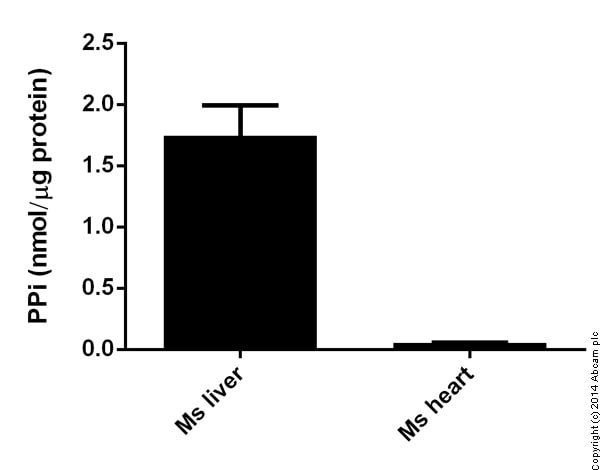Pyrophosphate Assay Kit (Fluorometric) (ab112155)
Key features and details
- Assay type: Quantitative
- Detection method: Fluorescent
- Platform: Microplate reader
- Sample type: Adherent cells, Cell culture extracts, Plasma, Serum, Suspension cells, Tissue Lysate, Urine
Overview
-
Product name
Pyrophosphate Assay Kit (Fluorometric)
See all Pyrophosphate kits -
Detection method
Fluorescent -
Sample type
Urine, Serum, Plasma, Cell culture extracts, Adherent cells, Suspension cells, Tissue Lysate -
Assay type
Quantitative -
Product overview
Pyrophosphate Assay Kit (Fluorometric) ab112155 provides the most robust spectrophotometric method for the measurement of pyrophosphate.
The pyrophosphate assay protocol uses a proprietary fluorogenic pyrophosphate sensor that has its fluorescence intensity proportionally dependent upon the concentration of pyrophosphate.
This pyrophosphate assay protocol is much easier and more robust than enzyme-coupling pyrophosphate methods, which require at least two enzymes for their pyrophosphate detections. Due to its direct measurement of pyrophosphate, this kit is ideal for screening inhibition or activities of enzymes that consume or generate pyrophosphate.
The pyrophosphate assay is an optimized mix-and-read assay and can be performed in a convenient 96-well or 384-well microtiter-plate format.
Assay time: 10-30 minutes
-
Notes
This product measures PPi formation at Ex/Em = 316/456 nm.
If your instrument has filters for Ex/Em = 370/470 nm, we recommend using Pyrophosphate Assay Kit II (Fluorometric) (ab179836).
Pyrophosphates (PPi) are produced by a number of biochemical reactions, such as ATP hydrolysis, DNA and RNA polymerizations, cyclic AMP formation by the enzyme adenylate cyclase and the enzymatic activation of fatty acids to form their coenzyme A esters.
-
Platform
Microplate reader
Properties
-
Storage instructions
Store at -20°C. Please refer to protocols. -
Components 2 x 96 tests Assay Buffer 1 x 25ml DMSO 1 x 200µl PPi Sensor 1 vial Pyrophosphate Standard (50mM) 1 x 1ml -
Research areas
Images
-
 Urinary total pyrophosphate (PPi) concentrations were determined using ab112155 Caballero D et al., PLoS One, 12(7). Fig 1a. doi: 10.1371/journal.pone.0180098 Reproduced under the Creative Commons license http://creativecommons.org/licenses/by/4.0/
Urinary total pyrophosphate (PPi) concentrations were determined using ab112155 Caballero D et al., PLoS One, 12(7). Fig 1a. doi: 10.1371/journal.pone.0180098 Reproduced under the Creative Commons license http://creativecommons.org/licenses/by/4.0/Urine PPi was corrected for urine creatinine, which was measured by LC-MS/MS or by ELISA using appropriate controls to adjust for inter-assay variability.
-
Pyrophospfate measured in cell lysates showing quantity (nmol) per 106cells
-
Pyrophosphate measured in tissue lysates showing quantity (nmol) per microgram protein
-
Pyrophosphate measured in biofluids showing concentration (micromolar). Obtained values were recalculated from 1:1000 sample dilutions.
-
Example PPi standard curve.
Data provided for demonstration purposes only.
-
Pyrophosphate, ATP and phosphate dose responses were measured with ab112155 in a solid black 96-well plate using a fluorescence microplate reader. As low as 1 µM (100 picomoles/well) pyrophosphate can be detected with 10 minutes incubation.

















